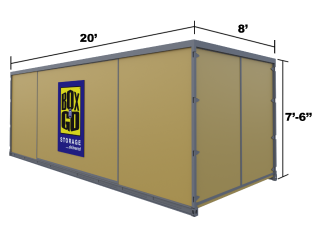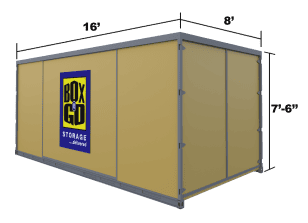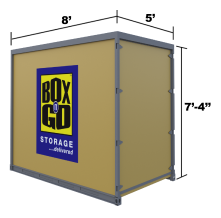


REVIEWS
RATING
GUARANTEE
Store on your driveway or inside our secure facility. Load/unload only once. Ground level access.


20’ Container – all weather.
Perfect for 3-bedroom residence.
5-7 rooms, furniture, appliances, etc.

16’ Container – all weather.
Perfect for 2-bedroom residence.
3-5 rooms, furniture, appliances, etc.

8’ Container – all weather.
Modular – works for any need.
Each fits 1-1.5 rooms.



- No truck to rent. We deliver storage to you!
- Load/Unload only once.
- Pay only for space you use.
- Secure, climate-friendly facility.
- Drive-up access
- Save money and time.
- Reduce the risk of accidents and injuries.
- No need to pay for gas, insurance & mileage!
- You only need to load your belongings once!
- No need to load and unload it all again into a storage unit.
- All containers come with easy ground level access!
(if storing at our facility)
- No not need to guess on how much space you actually need.
- Order an extra 8’ x 5’ unit. Do not use it – do not pay for it.
- Highest degree of security and protection.
- Our 8’ x 5’ units are breatheable – no mold or mildew.
- No funky smell when your belongings return.
(if storing at our facility)
- Access your units at ground level.
- No elevators, ramps, stairs to climb.
- Schedule access appointment & drive straight to your units.

Packing tips and techniques
The key to a successful storage and moving experience is proper packing … and the use of padding. Don’t skimp on packing supplies. They are far cheaper than broken or damaged belongings.
The following is a list of tools and materials to make your packing go more smoothly:
- Razor knife and/or scissors
- Note pad
- Dark, water-resistant marker
- Boxes of all sizes
- Packing tape
- Bubble wrap
- Packing peanuts
Leave lightweight linens and clothing in their drawers. Pack extra linens, pillows and stuffed animals in large garbage bags and tape closed. Plan to use these bags as cushions or fillers in your Box-n-Go storage container.
Disassemble any items you can. Be aware of items with sharp corners or projections and keep them from puncturing or scratching other objects.
Use clean cartons designed for moving. Boxes obtained from grocery or liquor stores are not always clean, and may not withstand the weight of the items that you’ll be putting in them. Also, their odd sizes tend to make loading more difficult.
Pack as much as you can into boxes. This will provide greater protection for your belongings and will make loading your Box-n-Go storage container much easier. Unusually shaped items take up more space and make loading more difficult.
Once you have developed a packing plan and have all the supplies you need, start packing:
Assemble boxes and tape all seams securely with sturdy packing tape. Reinforce the bottom of all boxes with tape. Seal cartons tightly with tape when they are finished packed.
Place a two- or three-inch layer of crushed paper in the bottom of cartons for cushioning.
Build up the layers, with the heaviest things on the bottom, medium weight next and lightest on top.
As each layer is completed, fill in empty spaces firmly with crushed paper and add more crushed paper to make a level base for the next layer, or use sheets of cardboard cut from cartons as dividers.
Cushion well with crushed paper; towels and lightweight blankets may also be used for padding and cushioning. The more fragile the item, the more cushioning needed. Be sure no sharp points, edges or rims are left uncovered.
Pack small, fragile, individually wrapped items separately or a few together in small boxes, cushioning with crushed or shredded paper. Place small boxes in a single large box, filling in spaces with crushed paper.
Wrap items individually in clean tissue paper, paper towels or even facial tissue for fine china, crystal and delicate items. Always place a layer of crushed paper in the bottom of the carton for cushioning. Fill empty spaces with additional crushed paper. Use a double layer of newsprint for a good outer wrapping. To prevent small items from being lost or mistakenly thrown out with the packing paper, wrap miniature knickknacks and other small items in brightly-colored tissue paper before placing them in the box.
Use newspapers for cushioning only. The ink can rub off and embed itself onto fine china.
Pack similar items together. For example, don’t pack a delicate china figurine in the same carton with cast-iron frying pans. Similarly, keep all parts or pairs of things together. For instance, curtain rod hangers, mirror bolts and other small hardware items should be placed in plastic bags and taped or tied securely to the article to which they belong.
Make sure the boxes are firmly packed to prevent shifting during the move, with heavier items on bottom and lighter ones on top. The cover should close easily without force, but should not bend inward. Plug up extra space with items you need to pack anyway, such as pillowcases, face cloths, and socks.
Place heavier items in small boxes so that they’re easier to carry. Lighter items can go in larger boxes. However, avoid loading more than 50 pounds into one box.
Pack plates and record albums on end vertically, rather than placed flat and stacked.
On the top and side of each carton, write a general description of the contents and indicate the room from which it came. Copy the list into a special notebook for your record. Use different colored dot stickers for each box; (if you are moving into a new home you can hang a balloon of a corresponding color outside the room where you want your color-coded boxes. This can make the entire process much easier. Mark fragile boxes on every side.
Packing Tips
Don’t apply tape directly to polished or painted wood finishes. Removing the tape could ruin the surface.
Double-box fragile items and add plenty of cushioning.
Pack breakables over the box you’re putting them in. This way, if you happen to drop an item, it will land on some packing material, therefore reducing the chance that it will break.
You should personally transport irreplaceable photos, financial papers and assets (bank checks, insurance policies, stock certificates, etc.), legal documents (wills, passports, etc.), valuables (jewelry, coin and stamp collections, etc.), and medical and family history records.

